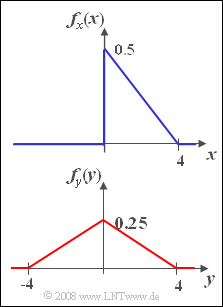Difference between revisions of "Aufgaben:Exercise 3.3Z: Moments for Triangular PDF"
From LNTwww
m (Text replacement - " rms " to " standard deviation ") |
|||
| Line 61: | Line 61: | ||
| − | {Calculate the | + | {Calculate the standard deviation of the random variable $y$. |
|type="{}"} | |type="{}"} | ||
$\sigma_y \ = \ $ { 1.633 3% } | $\sigma_y \ = \ $ { 1.633 3% } | ||
Revision as of 12:34, 17 February 2022
We consider in this exercise two random signals $x(t)$ and $y(t)$ each with triangular PDF, namely
- the one-sided triangular PDF according to the upper graph:
- $$f_x(x)=\left\{ \begin{array}{*{4}{c}} 0.5 \cdot (1-{ x}/{\rm 4}) & \rm for\hspace{0.2cm}{\rm 0 \le {\it x} \le 4},\\\rm 0 & \rm else. \end{array} \right.$$
- the two-sided triangular PDF according to the graph below:
- $$ f_y(y)=\left\{ \begin{array}{*{4}{c}} 0.25 \cdot (1-{ |y|}/{\rm 4}) & \rm for\hspace{0.2cm}{ -4 \le {\it y} \le \rm 4},\\\rm 0 & \rm else. \end{array} \right.$$
To solve this problem, consider the equation for the central moments:
- $$\mu_k=\sum\limits_{\kappa = \rm 0}^{\it k}\left({k} \atop {\kappa}\right)\cdot m_k\cdot(-m_{\rm 1})^{k - \kappa}.$$
Specifically, this equation yields the following results:
- $$\mu_{\rm 1}=0,\hspace{0.5cm}\mu_{\rm 2}=\it m_{\rm 2}-\it m_{\rm 1}^{\rm 2},\hspace{0.5cm}\mu_{\rm 3}=\it m_{\rm 3}-\rm 3\cdot\it m_{\rm 2}\cdot \it m_{\rm 1} {\rm +}\rm 2\cdot\it m_{\rm 1}^{\rm 3},$$
- $$\mu_{\rm 4}=\it m_{\rm 4}-\rm 4\cdot\it m_{\rm 3}\cdot \it m_{\rm 1}\rm +6\cdot\it m_{\rm 2}\cdot\it m_{\rm 1}^{\rm 2}-\rm 3\cdot\it m_{\rm 1}^{\rm 4}.$$
From the central moments of higher order one can derive among others:
- the "Charlier's skewness" $S = {\mu_3}/{\sigma^3}\hspace{0.05cm},$
- the "kurtosis" $K = {\mu_4}/{\sigma^4}\hspace{0.05cm}.$
Hints:
- This exercise belongs to the chapter Expected Values and Moments.
- Reference is made to the section Some common central moments.
Questions
Solution
(1) For the $k$–th order moment of the random variable $x$ holds:
- $$m_k=1/2\cdot \int_{\rm 0}^{\rm 4} x^k\cdot ( 1-\frac{\it x}{\rm 4}) \hspace{0.1cm}{\rm d}x.$$
- This leads to the result:
- $$m_k=\frac{x^{ k+ 1}}{ 2\cdot ( k+ 1)}\Bigg|_{\rm 0}^{\rm 4}-\frac{x^{ k+2}}{8\cdot ( k+2)}\Bigg|_{\rm 0}^{\rm 4}=\frac{\rm 2\cdot \rm 4^{\it k}}{(\it k\rm +1)\cdot (\it k\rm + 2)}.$$
- From this we obtain for the linear mean $(k= 1)$:
- $$m_x=\rm {4}/{3}\hspace{0.15cm}\underline{=1.333}.$$
(2) The $(k= 2)$ is $m_2 = 8/3$.
- From this follows with "Steiner's theorem":
- $$\sigma_x^{\rm 2}={8}/{3}-({4}/{3})^2=\rm {8}/{9}\hspace{0.5cm}\Rightarrow\hspace{0.5cm} \sigma_x\hspace{0.15cm}\underline{\approx \rm 0.943}.$$
(3) With $m_1 = 4/3$, $m_2 = 8/3$ and $m_3 = 32/5$, the given equation for the third order central moment gives: $\mu_3 = 64/135 \approx 0.474$.
- From this follows for the "Charlier's skewness":
- $$S_x=\rm \frac{64/135}{\Big(\sqrt {8/9}\Big)^3}=\frac{\sqrt{8}}{5}\hspace{0.15cm}\underline{\approx 0.566}.$$
- Due to the asymmetric PDF: $S_x \ne 0$.
(4) Correct are the proposed solutions 1, 3 and 4:
- For symmetric PDF, all odd moments are zero, including the mean $m_y$.
- Therefore, according $y$: There is no difference between the moments $m_k$ and the central moments $\mu_k$.
- The moments $m_k$ with even $k$ are the same for the random variables $x$ and $y$. This is evident from the time averages:
- Since $x^2(t) = y^2(t)$, for $k = 2n$ the moments are equal too:
- $$m_k=m_{2 n}=\ \text{...}\int [x^2(t)]^n \hspace{0.1cm}{\rm d} x=\ \text{...}\int [y^2(t)]^n \hspace{0.1cm}{\rm d} y.$$
(5) With the result of the subtask (2) holds:
- $$m_2=\mu_{\rm 2}=\sigma_y^2=\rm {8}/{3} = 2.667\hspace{0.3cm}\Rightarrow\hspace{0.3cm} \sigma_y\hspace{0.15cm}\underline{=1.633}.$$
(6) For symmetrical PDF, the fourth-order central moment is equal to the moment $m_4$.
- From the general equation calculated in subtask (1) one obtains $\mu_4 = 256/15.$
- From this follows for the kurtosis:
- $$K_y=\frac{\mu_{\rm 4}}{\sigma_y^{\rm 4}}=\rm \frac{256/15}{(8/3)^2}\hspace{0.15cm}\underline{=2.4}.$$
- Note: This numerical value is valid for the triangle PDF in general and lies between the kurtosis values of the uniform distribution $(K = 1.8)$ and the Gaussian distribution $(K = 3)$. This is a quantitative evaluation of the fact that here
- the outliers are more pronounced than in the case of a uniformly distributed random size,
- but due to the limitation less pronounced than with Gaussian sizes.
- Note: This numerical value is valid for the triangle PDF in general and lies between the kurtosis values of the uniform distribution $(K = 1.8)$ and the Gaussian distribution $(K = 3)$. This is a quantitative evaluation of the fact that here
- Then we will prove that the asymmetric triangular PDF $f_x(x)$ has the same kurtosis as shown in the upper sketch on the data sheet:
- $$\mu_{ 4} = m_{\rm 4}- 4\cdot m_{\rm 3}\cdot m_{\rm 1}+ 6\cdot m_{\rm 2}\cdot m_{\rm 1}^{\rm 2}- 3\cdot m_{\rm 1}^{\rm 4}= \frac{256}{15} - 4 \cdot \frac{32}{5}\cdot \frac{4}{3} + 6 \cdot \frac{8}{3}\cdot \left(\frac{4}{3}\right)^2 -3 \cdot \left(\frac{4}{3}\right)^4 =\frac{256}{15 \cdot 9}$$
- With the result of the subtask (3) ⇒ $\sigma_x^2 = 8/9$ it follows:
- $$ K_x = \frac{{256}/(15 \cdot 9)}{8/9 \cdot 8/9} = 2.4.$$
